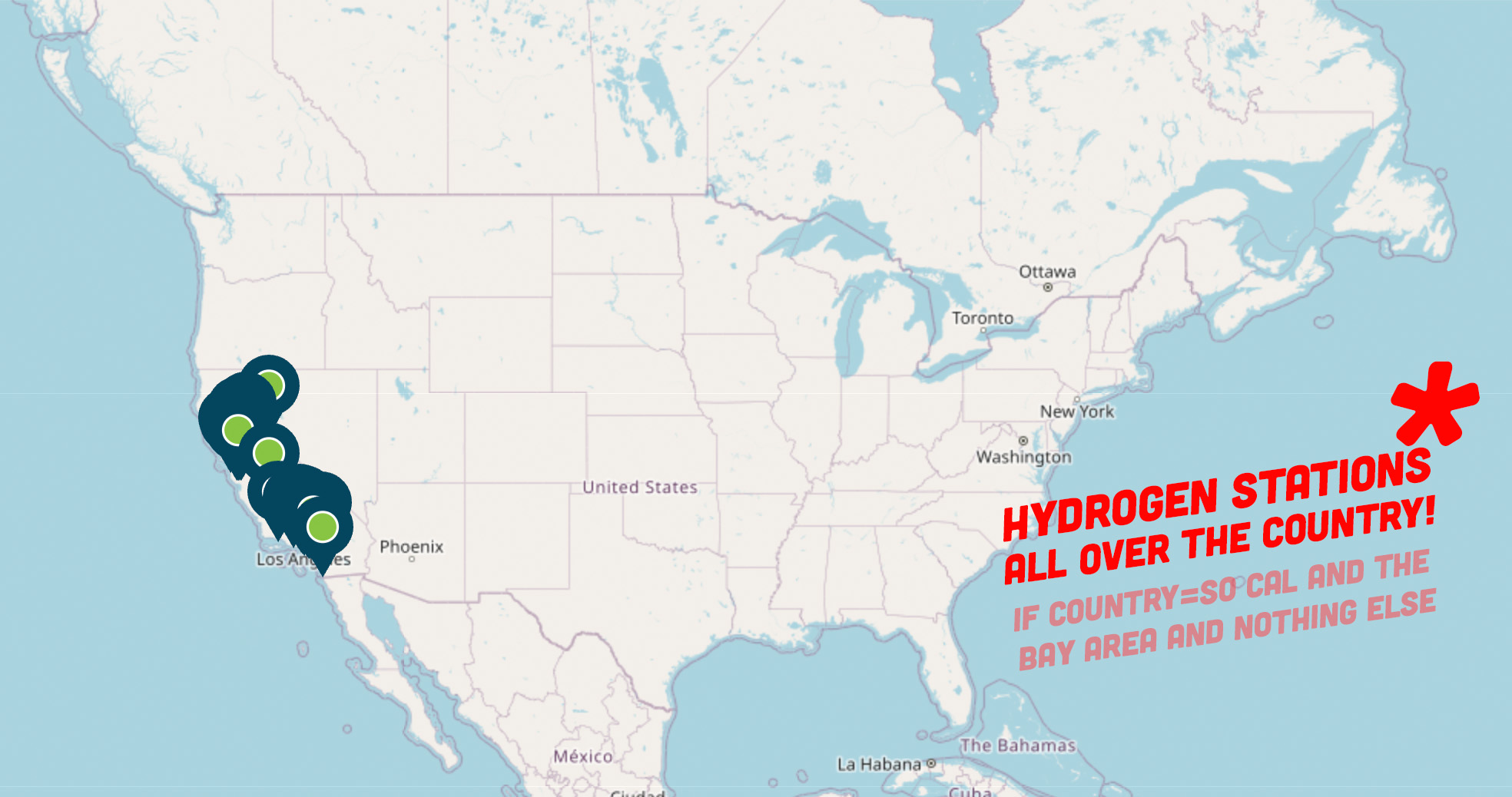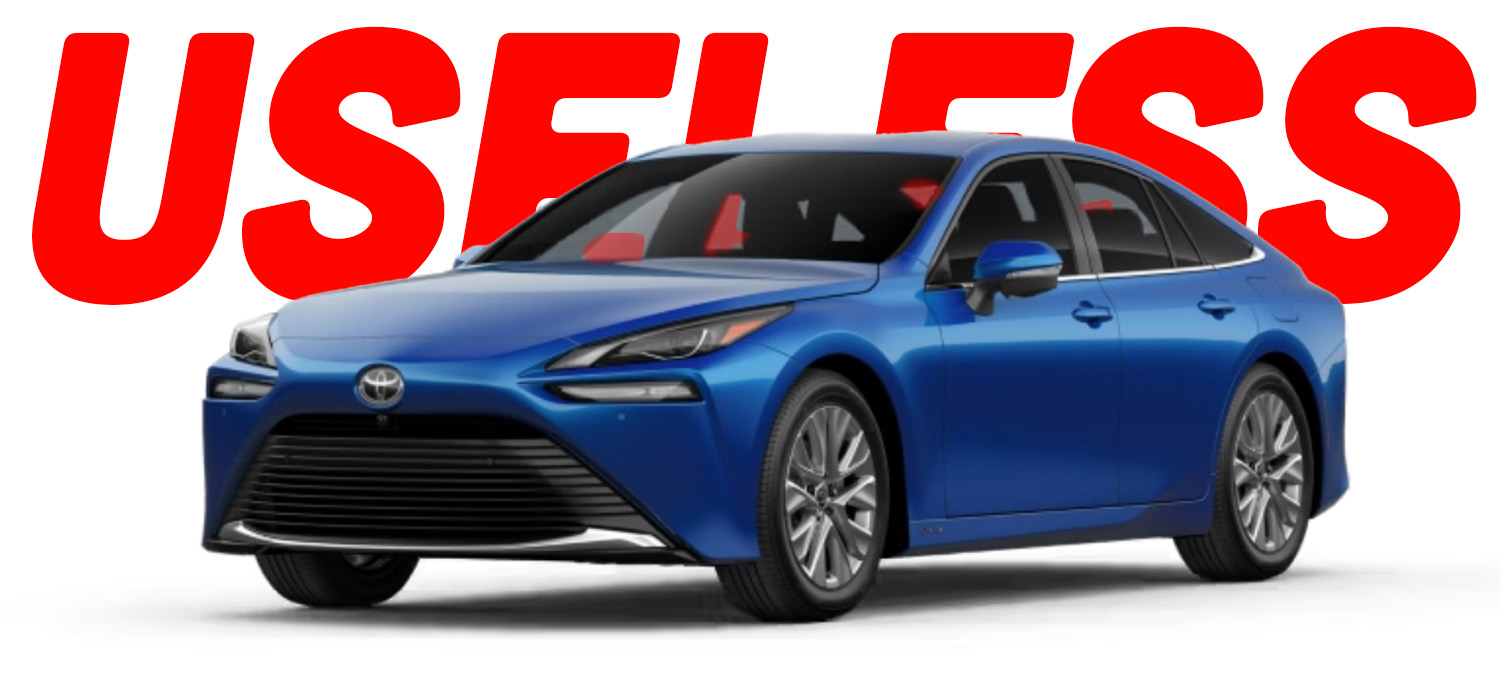I’ll be honest with you, and honest with Toyota, just in case they’re reading this also: I’ve never really understood Toyota’s fascination – perhaps even fixation – on hydrogen cars. I mean, I get the general appeal of it all – hydrogen is the most abundant element in the universe, after all, and if you’re using that hydrogen to power a fuel cell to make electricity (as Toyota does) then the only emissions are pure, clear water. It’s very appealing! On paper, at least.
Reality, though, as usual, is kind of a jerk. Hydrogen may be everywhere in the universe, but here on Earth, where currently Toyota sells 100% of their cars, hydrogen is not that easy to get, and must be produced from other hydrocarbon fuel using thermal-based methods or electrolysis, and so on. It’s not just all floating around out there.
It’s also tricky to store, and a whole new infrastructure for fueling hydrogen needs to be developed, and now we’re getting closer to the whole point of this post: Toyota has been talking about an extensive network of public hydrogen filling stations that will come in the future, but over a decade has passed since the first Mirai hit the market, and as of now there are really only some stations in Southern California (and a handful in Canada if you’re Canadian).
This means that Mirai owners are finding themselves with cars that have pretty severe limitations; you simply can’t take a multi-state road trip in a Mirai, because there’s simply nowhere to refuel. If you own a Mirai, you’re pretty much tethered to whatever California hydrogen station you’re close to. And even then, the refueling situation isn’t great.

“Isn’t great” is something of an understatement, and the proof of this is that there are hundreds of Mirai owners who are in the process of suing Toyota over problems with hydrogen fueling, including chronic failures of pumps and limited supplies, and also claims that Toyota dealers dramatically oversold the usability of Mirais and did not adequately warn potential buyers of the severe limitations of the car.

The lawsuit contains a number of personal stories from Mirai owners, and in many of these you can see a combination of a poor refueling infrastructure and what seems to be willful misinformation or, at the very least, exaggeration from Toyota dealers looking to get these Mirai albatrosses off their lots. To be clear, I’m not saying there actually was any deliberate fraud or misinformation – that’s for the courts to decide.
When reached for comment, a Toyota spokesperson told us that the company doesn’t generally comment on pending litigation.
Here’s how the lawsuit describes the situation:
“This action arises from Toyota Motor Sales, U.S.A., Inc.’s fraud in the marketing, sale, and support of its Toyota Mirai hydrogen fuel cell vehicle. Plaintiffs, who represent diverse California consumers including military personnel, seniors, and working families, purchased Toyota’s hydrogen-powered Mirai based on explicit promises of convenient refueling, environmental benefits, and practical usability.
Instead, they received vehicles that are virtually unusable due to a critically deficient hydrogen infrastructure consisting of only 24 fuel nozzles across California, most of which are frequently inoperable.”
There’s also the extremely severe depreciation of Mirais at play here; likely because of the known issues with the cars and their extremely limited sphere of actually being able to be used, Mirais lose a shocking amount of their value quite fast – the lawsuit claims a 90% drop after purchase.
The personal stories of Mirai owners do paint a troubling picture; this one from Zachary Graham, a Second Lieutenant in the Marine Corps, is especially maddening, and I think you’ll see why:
61. Off the bat, Mr. Graham told said Toyota sales associate, [REDACTED], that he was in the military and required flexibility to return the vehicle if he’s stationed out of state.
62. [REDACTED] was explicit that this could be accommodated, and he proposed a finance agreement for a 2023 Toyota Mirai, highlighting several incentives, including free hydrogen fuel, in the form of a fueling card to pay for fuel at the pump.
63. During this sales process, the sales manager, [REDACTED], touted the benefits of the Mirai to Mr. Graham, including the benefits to the environment and the explicit promise of free hydrogen fuel, and that refueling hydrogen is an easy straightforward process.
64. Based on these incentives and assurances, Mr. Graham agreed to purchase the Toyota Mirai for an expensive $42,358.93. The promise of free fuel made the expensive purchase make sense to Mr. Graham.
65. Quickly after the purchase, Mr. Graham discovered that fueling the car with hydrogen fuel is practically not possible.
66. For example, when there are cars ahead of him at a fuel station it takes well over an hour to obtain any fuel. This is because there’s a long wait in between each customer for the pump to recompress and dispense fuel and the pumps never fill the car up totally.
Right from the get-go, you’d think a salesperson would have steered Graham away from a car that could only be used in one state if that person knew they may relocate, regardless of whether they planned to return the vehicle or keep it.

It seems that this severe limitation was not even brought up:
76. Moreover, soon after he bought the vehicle, he learned that hydrogen fuel stations are exclusively located in California.
77. This stifling fueling limitation was not disclosed to Mr. Graham by [REDACTED], [REDACTED], or any other personnel at the dealership during the sales transaction or otherwise. Further, nothing in Mr. Graham’s paperwork he signed with Toyota discloses this critical fueling limitation.
78. Mr. Graham is under military orders to leave California and has left to Virgina, where he cannot bring his car with because there’s absolutely zero fuel out of California.
So, Graham has orders to move to Virginia, but he finds out he can’t take his car there because he can’t refuel it, and when he tries to sell the car back, he finds the appraised value is $11,000, putting him over $24,000 in the hole.
This is, of course, miserable.
Now, sure, one could argue that some of the burden is on the buyer – you should do some research on your car purchases, especially for something as crucial as where it can be refueled. But that only goes so far; the dealer knew this limitation of the car, Graham clearly stated he need to move, and the dealer made no attempt to explain to this potential Mirai buyer that should he move to any place other than Southern California or the Bay Area, that Mirai would be, at best, yard art.
Graham’s example is far from the only one, and some seem to be even more explicit; it also seems that comparisons to the Toyota Prius were used to make the Mirai seem more viable and practical, as in this example involving 77-year-old Jamie Nahman:
102. Critically, [REDACTED] explicitly and repeatedly juxtaposed the Mirai to thePrius.
103. [REDACTED]told Mr. Nahman that the Mirai was going to take off like the Prius and said it was a great deal like the Prius and that Mr. Nahman was lucky that he was getting in early!
104. [REDACTED] made an explicit promise to Mr. Nahman and his wife that within one year hydrogen stations will be everywhere, even outside California.
The Mirai is really nothing like the Prius, aside from them both being Toyotas and being primarily eco-focused vehicles. A Prius can refuel with regular gasoline, anywhere in the world, easily. A Mirai, as we’ve noted, can very much not.
Also, the “explicit promise” that there would be many more hydrogen stations not just in California, but other places, seems downright deceptive.
Of course, there’s a lot more in the lawsuit ( and this one isn’t the only one ) including many claims of hydrogen fueling station pumps not working, including situations where the pump can literally freeze in the car, limited supplies where owners are restricted to getting 1/5 of a tank of hydrogen, absurdly long refueling times (going against Toyota’s claims of “ five minutes “) and complaints that the range of the Mirai is nowhere near the Toyota’s claim of over 400 miles.
In fact, our own David Tracy heard a Mirai owner tell him just that when he spoke to one at a hydrogen fuel station:
Oh, and the fuel is expensive as hell, too, just in case all of this wasn’t enough for you.
I wish I were more surprised by any of this. I’ve driven a Mirai before, and they’re nice enough cars, but they’re also the only car for sale right now that I would absolutely and confidently warn anyone not to buy. Ever. There is absolutely no good reason to buy a Mirai, unless your plan is to have an excuse never to drive anywhere at all, ever – for that purpose, I really can’t think of a better car.
I don’t know if this will finally cool Toyota’s ardor for hydrogen – if it doesn’t, I have no idea what will. But, then again, I never really understood what Toyota’s plan was for hydrogen in the first place. Things definitely don’t seem to be progressing in the way they want, and at some point I would hope dealers will finally understand and be honest what they’re trying to sell to people: one of the most advanced, and well-designed and completely useless (and valueless) cars one can buy on the market today.
The post Toyota Is Being Sued By Hundreds Of Mirai Owners Because Owning A Hydrogen-Powered Car Is Just Awful appeared first on The Autopian .